Engines Powered by the Forces Between Atoms
By Fabrizio Pinto
By manipulating van der Waals forces, it may be possible to create novel types of friction-free nanomachines, propulsive systems, and energy storage devices.
By manipulating van der Waals forces, it may be possible to create novel types of friction-free nanomachines, propulsive systems, and energy storage devices.

DOI: 10.1511/2014.109.280
Why does the world stick together, rather than falling apart?
Isaac Newton grappled with this question in the preface to his Philosophiae Naturalis Principia Mathematica, first published in 1687:
For I am induced by many reasons to suspect that they may all depend upon certain forces by which the particles of bodies, by some causes hitherto unknown, are either mutually impelled towards each other and cohere in regular figures, or are repelled and recede from one another; which forces being unknown, philosophers have hitherto attempted the search of Nature in vain.
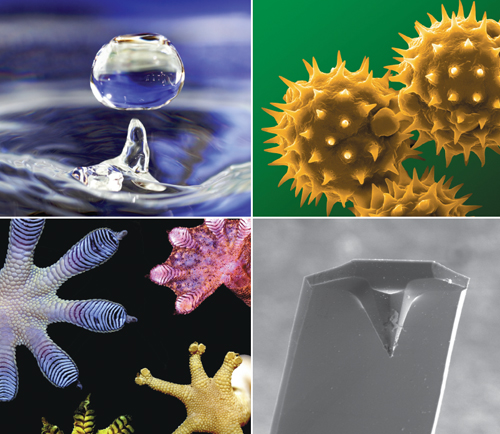
It was not until the late 1800s that Dutch physicist Johannes Diderik van der Waals came up with a convincing explanation, based on assuming weak, short range forces between atoms. The search for Newton’s “certain forces” continued until 1927, when Shou Chin Wang, a Chinese doctoral student at Columbia University, calculated the force between two hydrogen atoms using the then-novel quantum wave mechanics, which describes the behavior of particles on the atomic scale. The key to this theory of interatomic forces is that any atom instantaneously generates what is called an electric dipole field—at any point in time, the negative electrons are not evenly distributed around an atom, leading to a temporary positive charge on one side of the atom and a corresponding negative charge on the other, making the atom polarized. A nearby atom interacts with these charges, thereby producing a field that propagates back to the original atom. Finally in the 1930s this approach was fully analyzed by German-American physicist Fritz London. Because of the connections between this research and optical theory, London introduced the term “dispersion effect,” and these forces collectively are called dispersion forces. (See also “Little Interactions Mean a Lot,” March–April 2014.)
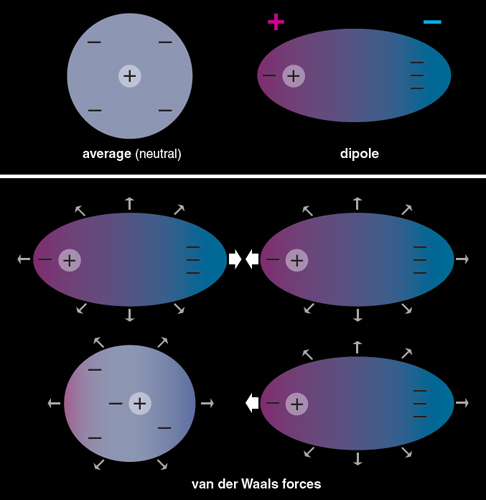
Illustration by Tom Dunne.
This attraction between atoms and molecules, whether known as the van der Waals force or the dispersion force, gives major clues about the cohesion of materials, and has become a standard part of even the high school–level curriculum in chemistry and physics. However, much about these forces remains a source of mystery and discovery, and they hold great potential for understanding and manipulating the world, particularly on the nanometer scale. Dispersion forces may seem to be stuck in the realm of static solids—after all, they are part of what compels fleeting gaseous particles to stick together into more substantive forms—but new methods for controlling and tailoring them could allow their use in devices that move, to transform energy and yield propulsion. By combining several new cutting-edge technologies, including carbon nanotubes, it may be possible to create entirely new mechanisms that can act as batteries or motors, storing or releasing energy as required, without the need for onboard chemical fuel.
Although van der Waals forces operate at the tiny distances between atoms and molecules, their behavior also manifests on a bulk scale. The quantity that London derived, now known as the van der Waals–London potential, decays with distance between atoms, but is also proportional to how much the electrons in the atoms are free to move around, which affects their polarizability—if the electrons are so stuck in place that they cannot alter their position in relation to another atom’s dipole field, they will not be able to respond to those induced charges. Additionally, London proposed that dispersion forces are additive, so that the total force between two objects should be the sum of all forces exerted by atoms in one body on all atoms in the other. Logically, the van der Waals potential should therefore be approximately proportional to the number of atoms in each slab squared. These results imply that the van der Waals forces between two plates can be computed by observing the optical properties of the bulk material, rather than starting from the individual atoms.
But it was also apparent from experiments, which used systems of macroscopic interacting particles dispersed in a medium (referred to as colloids), that the van der Waals potential between any two such particles separated by a gap decayed more quickly at long range than would be expected for assemblies of individual atoms, so some other effect was in play.
In the mid-1940s, Dutch physicist Hendrik B. G. Casimir, in collaboration with Dirk Polder, unraveled some of the mystery. Many years later, he communicated to Peter W. Milonni, then at Los Alamos National Laboratory, that his insight began in 1947 on a walk with Niels Bohr, who “mumbled something about zero-point energy.” Casimir’s novel strategy was not at all based on individual atoms, other than to assume that the two plates are perfect reflectors, but on space itself.
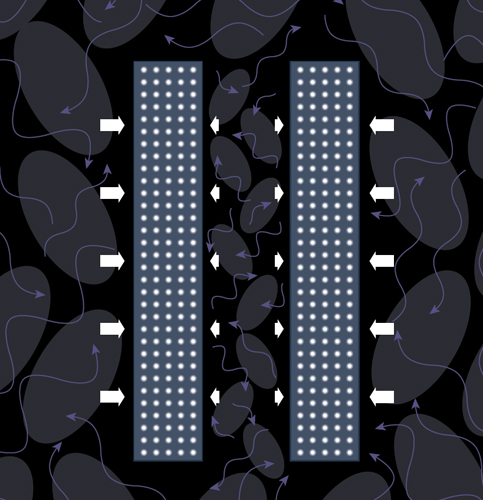
Illustration by Tom Dunne.
The uncertainty principle, described in the 1920s by Werner Heisenberg, states that pairs of specific observable quantities, such as the momentum and the position of a particle, cannot both be simultaneously known with infinite accuracy. This principle also applies to observables of the electromagnetic field, so that, even when space is classically “empty” and in its lowest energy state (at what is called its zero-point energy), random vibrations still exist and we must visualize this quantum vacuum as a sea of ever-appearing and disappearing virtual photons. The presence of the two parallel plates in space prevents the presence of vibrations with wavelengths longer than the gap width. Because there are more vibrations with longer wavelengths outside the plates than inside the plates, this arrangement results in a net radiation pressure that pushes the plates together, even though the plates are neutrally charged and should not experience any attractive force. The effect is named after Casimir. However, the root source of the attraction is related to dispersion forces on the atomic scale, because it is closely tied to the interactions between pairs of fluctuating dipoles in each slab. In practice, about 80 percent of the correct Casimir force between two slabs can be found just by adding the forces between pairs of atoms, one in each slab, over all atoms in both slabs (this method is referred to as a pairwise sum). But, rigorously speaking, dispersion forces are actually not simply additive, and this pairwise approximation at times fails in dramatic ways, exemplifying that even estimating this force correctly can be tricky.
(In the animation below, American Scientist interprets the Casimir Effect in action.)
Casimir’s theory provided a rigorous proof that dispersion forces must decay more quickly at long range when the travel time of light across the gap becomes large compared to the typical time needed for atomic transitions. This is called the retarded regime, in contrast with the regime of typical van der Waals forces treated by London, which is referred to as unretarded.
(In the video below, Michael Stevens of VSauce discusses the vacuum, and at 5:25, he shows the Casimir Effect.)
Since Casimir’s discovery, a number of teams have attempted to show tangible manifestations of his theory. Evgenii M. Lifshitz provided a masterful synthesis in his theory of dispersion forces, formulated in 1955 as a “purely macroscopic approach” requiring no additivity of forces. In practice, “it is easier to set the distance between a sphere and a plane than between two planes, which must be held parallel.” Thus Boris V. Derjaguin and Irina I. Abrikosova in 1951 developed the strategy adopted in most experiments to employ a spherical body-plane geometry.
The attraction between two neutral plates has elicited dramatic commentary, such as that of Nobel Prize–winning physicist Julian Schwinger, then at the University of California at Los Angeles, and his collaborators, who described it as “One of the least intuitive consequences of quantum electrodynamics.” It is useful to contrast such nearly mystical views with the proof by Peter W. Milonni and others in 1988, following a hint by physics Nobel prize–winner Peter Debye in his Baker Lectures (published posthumously in 1967), that the Casimir force is the difference between the radiation pressure due to the virtual photons on the outward side of each plate and the gap-facing side.
This description also suggests the possibility of using classical physics, instead of quantum electrodynamics, to postulate a random electromagnetic field present even in the absence of any sources. This theory, called stochastic electrodynamics, was shown by Timothy H. Boyer at the City College of the City University of New York and others, to reproduce the Casimir effect without explicit reference to quantization, thus providing a more approachable verbal description. Although the physical implications have been fiercely debated, the impressive mathematical résumé of stochastic electrodynamics is not widely considered to show that it can replace quantum electrodynamics.
The radiation pressure interpretation has led to experiments by André Larraza and his collaborators at the Naval Postgraduate School, commencing in 1997, in which the random field is not electromagnetic but acoustic and produced by noise generators and compression drivers inside an enclosed chamber. The power spectrum, which the experimenters defined within a finite frequency band, yields an acoustic Casimir force that is observed to oscillate as a function of the gap width, instead of decaying according to a power law, and even becomes repulsive at specific distance ranges.
Similar departures from the “traditional” Casimir force, obtained by allowing only narrow frequency bands of the zero-point field to contribute to the total pressure, had also been theoretically shown in 1991 by Charles Adler and Nabil Lawandy, then both at Brown University, and in 1993 by Enrico Iacopini at the Universitá di Firenze and by Lawrence H. Ford of Tufts University, to introduce wild oscillations, extreme force enhancements, and sign reversals in the electrodynamic case as well. However, another debate has raged as to whether such predictions violate the causality principle.
Although the theoretical and experimental debates continue, dispersion forces have already found practical use in several arenas. The most successful one thus far is arguably the atomic force microscope, developed in the 1980s. Unlike an optical microscope, the atomic force microscope uses a flexible cantilever attached to a sharp probe—with a tip on the nanometer scale—to feel the topography of a surface down to the scale of individual atoms. Dispersion forces between the tip and the surface deflect the cantilever and are translated into images.
The cantilever and probe of the atomic force microscope are increasingly manufactured using microelectromechanical system (MEMS) technologies, which use the techniques of computer chip fabrication to incorporate electronics, sensors, and even moving parts into micrometer-scale devices. Van der Waals forces have always been intrinsically important in MEMS, because at these scales, these forces dominate far more than gravity and even electrostatic forces, and cause a crippling limitation called stiction.
As physicist Richard Feynman pointed out in his classic 1959 lecture There’s Plenty of Room at the Bottom, van der Waals forces become so strong on the microscale that everything sticks together: “It would be like those old movies of a man with his hands full of molasses, trying to get rid of a glass of water.” However, for the past decade a number of researchers have been exploring ways to harness these forces for mechanical work in MEMS devices. And as Larraza’s group found in the acoustic case, it was expected there could be some methods to make Casimir forces repulsive so as to overcome the limits created by stiction at MEMS scales.
My motivating questions in dispersion force research have focused on creating new technologies to exploit the energy exchange that occurs in thermodynamical engine cycles built around these interactions. In the late 1990s, I could find no mention of van der Waals forces as an enabling factor. In the physics literature, the Casimir force was described as only a “tiny force,” possibly following Casimir’s own assessment that “the effect is small.” Yet as Feynman had anticipated, dispersion forces can completely dominate matter dynamics on the nanoscale, so one would think that their collective effect could have a substantial technological potential.
One early study to rectify the view of “negligible” dispersion forces was the now often cited mathematical analysis by F. Michael Serry, Dirk Walliser, and G. Jordan Maclay, then at the University of Illinois, proving in 1995 that Casimir forces in a realistic MEMS oscillator render the system highly nonlinear, or anharmonic. Their prediction that “such effects may be amenable to functionality when they are well understood and exploited” in part motivated my new research focus. However, the “weak” Casimir force myth endured. A 2001 article in the New York Times, on the first successful demonstration of Casimir force actuation in MEMS devices by Federico Capasso’s group at Bell Laboratories, was still puzzlingly titled “A Tiny Force of Nature is Stronger than Thought.”
Within the same 2000–2002 timeframe, Kellar Autumn and his collaborators, working at Lewis & Clark College, demonstrated that dry adhesion by van der Waals forces explains the remarkable climbing abilities of geckos, even leading to nanofabricated adhesion products referred to as “gecko glue.” Therefore, in just a few years, dispersion forces went from being described as “too weak to command great attention” to enabling the millions of hairs in a gecko foot, ideally, to “support the weight of two medium-sized people” (see “How Gecko Toes Stick,” March–April 2006).
Although awareness of the potential of dispersion forces in nanotechnology is relatively recent, the development I deem responsible for setting van der Waals forces into slow motion toward the application realm is over 40 years old. This advance was the dynamic detection strategy devised at the Technische Universität München as part of Siegfried Hunklinger’s doctoral dissertation in 1969 and described by him and his colleagues in the Review of Scientific Instruments in 1972.
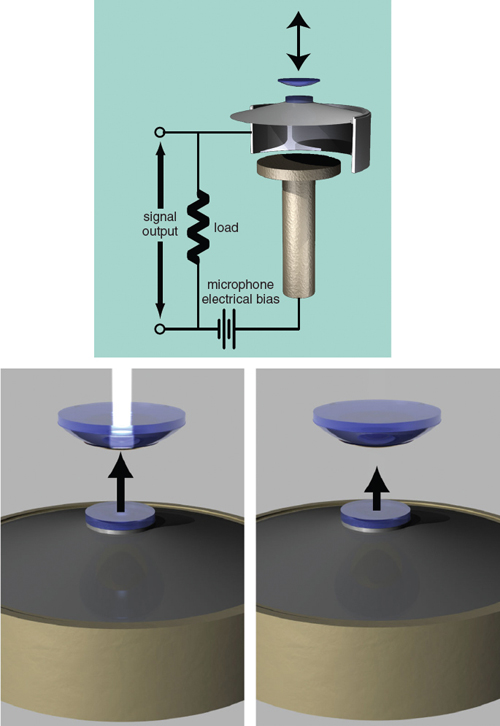
Digital graphic is copyrighted by Fabrizio Pinto and used with permission.
In these experiments, a modified microphone is forced to oscillate in a vacuum near another surface attached to a speaker diaphragm, which is positioned within a micrometer and vibrating at the microphone’s resonance frequency. This setup is not directed at demonstrating energy exchange but it provides a substantial logical step beyond the anharmonic Casimir oscillator later studied theoretically by G. Jordan Maclay and his colleagues. In the latter, the nonlinear oscillator is fully conservative (meaning no net energy is added to or subtracted from the system), frictional forces are neglected, and no role is played specifically by the Casimir force to alter the total initial energy of the system.
The Hunklinger experiment, on the other hand, demonstrated that the van der Waals force can carry out mechanical work by actuating even a macroscopic object, defying the reasoning that such forces were too weak to do any real work. Part of this work is transformed into electrical energy, which can be dissipated on a load. Of course, electrical energy ultimately appears in this experiment because, unlike for Maclay’s oscillator, its sensor system is not conservative but driven by the vibrating speaker-lens assembly via its own external energy source—an example where the system can be modified to produce a useful output.
In 1983–1984, physicist, inventor, and science fiction writer Robert L. Forward boldly proposed employing dispersion forces to produce an electric current. In one of his idealized devices, parallel plane conducting sheets are connected by wires and are kept equally charged by a voltage source. The Casimir force between adjacent sheets pulls them together against a simultaneous electrostatic repulsion. Although this system is inherently unstable, one of Forward’s most enduring contributions before his death in 2002 is to have identified what he referred to as a “vacuum-fluctuation battery,” in which part of the van der Waals potential energy of the surface interactions is converted into electrical energy.
In recent years, I have reconsidered the possibility of storing energy in the dispersion force field by addressing the severe limitations of Forward’s suggestive but impractical devices. This effort led me to focus on multiwalled carbon nanotubes because their specific area (the area of the interacting shell surfaces available per unit mass) is far greater than in the archetypal parallel plane geometry, and because the gap width is far smaller than the typical micrometer range. For instance, the specific area of carbon nanotubes has been estimated to reach values as large as 2 million square meters per kilogram whereas the intershell distance is approximately equal to 0.34 nanometer.
The concept is to have the inner shell of a double-walled nanotube telescope in and out, much like the piston in an engine, to produce energy or do work. Each shell could potentially be made of atoms other than carbon, because different materials produce more substantial Casimir forces. Order of magnitude estimates have shown that in dense arrays of such parallel double-walled nanotubes, the van der Waals energy density can reach values as high as 300 watt-hours per kilogram, an improvement over typical electrochemical batteries, which store on the order of 10 to 100 watt-hours per kilogram.
Electrochemical batteries have intrinsic limits on energy storage density. Casimir forces can provide the basis for strategies to store energy at unprecedentedly high density with respect to contemporary standards. An increase in energy density of a factor of 20, for instance, would mean being able to power electric cars capable of traveling from coast to coast in the United States on one charge, or to manufacture next-generation solar panels capable not only of converting light to electricity but also of storing and releasing energy until the next dawn or sunny day. Nanodevices based on van der Waals forces are also anticipated to be able to release energy at rates that can vastly exceed those of batteries and even supercapacitors, thus possibly providing a solution to the task of storage and high power release, while outperforming presently known mechanisms.
In his original report, Forward pondered whether dispersion forces are conservative, that is, whether work done by them over a closed path always vanishes. The possibility of a negative answer was disturbing to him: “It is very probable that [the vacuum fluctuation field] is conservative . . . otherwise it would be possible to design machines using the Casimir force that would allow an infinite amount of energy to be extracted from the vacuum.” Such an outcome was disturbing because it would violate the principle of the conservation of energy, allowing limitless power at no cost. This reasonable position is often still uncritically repeated, as in the New York Times article about the Casimir effect: “The effect cannot be tapped as a continuous power source, though, since pulling the plates apart takes as much energy as is released when they come together.”
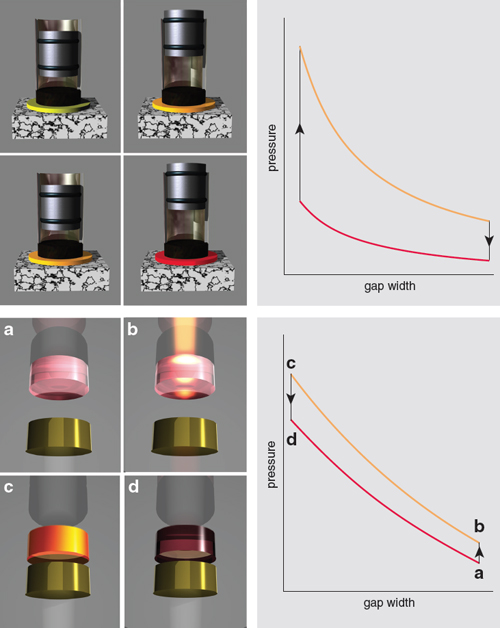
Digital graphic is copyrighted by Fabrizio Pinto and used with permission.
However, results reported in a paper authored by Hunklinger and his colleagues in the journal Physical Review B in 1979 had already shown a way around this concern. In what I consider one of the most consequential physics experiments of the 20th century, because of its implications for energy conversion and storage, those authors expanded their previous research to investigate the effects of illumination on van der Waals forces. Their motivation was that, in semiconductors, charge carriers can be excited from valence band to conduction band by illuminating the sample with light of an appropriate wavelength, thus altering the dielectric function, which describes the optical properties of materials and determines dispersion forces. This study was backed up by Lifshitz’s work: Because an excess of carriers corresponds to an increase in conductivity, his theory predicts an increase of the dispersion force in an illuminated sample.
To test this prediction experimentally, a spherical lens attached to a speaker diaphragm was covered with a dot of amorphous silicon in its center, which was then back-illuminated with white tungsten light. The speaker-lens assembly was set close to a small silica disk attached to the center of the microphone membrane, and as it was driven, the microphone responded to a periodic force conclusively larger when the lens was illuminated than when in darkness.
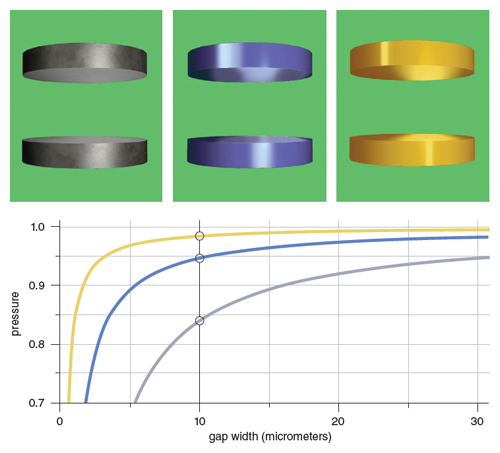
Digital graphic is copyrighted by Fabrizio Pinto and used with permission.
However, the experimental results did not conform in all detail to the predictions made by the Lifshitz theory. Among several factors still being debated, I have investigated the idealized assumptions made in the electrostatic calibration of the microphone system, whereas other researchers have stressed the limitations posed by using glass, an insulator, instead of a conductor as the sensor element. Indeed, a fertile area of research has arisen around the subject of checking discrepancies in experiments related to the Casimir force, and there may be some cause to refine the present theory in the case of semiconductors. In the meantime, it is certain that light can modulate the Casimir force in semiconductors, but further experiments are required to ensure confirmation of the theoretical expectations from quantum electrodynamics. For instance, modified atomic force microscopes have been used by Umar Mohideen and his group at the University of California, Riverside, to provide yet another experimental method to explore Casimir forces and their dependence on environmental conditions.
In 1998, I realized that the original experimental data on the effects of illumination on van der Waals forces mean it is possible to use the forces between atoms to run an engine cycle that is analogous to the steam engines in locomotives— it could even be possible to scale up such an engine from the nanoscale to a macroscopic size to store enough energy to run or to propel something as big as a satellite. From dispersion force engines capable of actuating nanosurgical robots deep inside the human body to high-density energy storage and next- generation thrusters both on the ground and in space, we are now learning to exploit dispersion forces to purposefully build and operate devices.
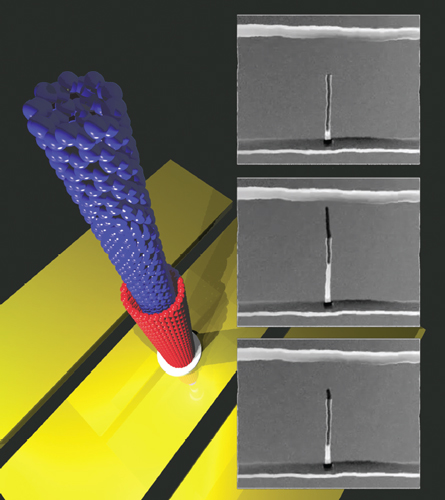
Digital graphic is copyrighted by Fabrizio Pinto and used with permission.
For instance, consider a cycle in which two semiconducting surfaces are first drawn together while illuminated, which increases the dispersion force, and then they are pulled apart in darkness, when the force is smaller. The net work done by the dispersion force is obviously nonzero, unlike the above oversimplifications repeated in the mainstream press. Emphatically, this does not mean that an infinite amount of energy can be “tapped” because imposing any change on the dielectric function also requires energy, such as that provided by the tungsten light in the microphone detection experiment. Therefore the total energy still can be conserved, so long as the net work done in a closed cycle equals the net energy exchanged with heat reservoirs external to the system.
My initial motivation was twofold: First, for nanomachines to function, they will need entirely new approaches to actuation and energy storage and delivery. Second, I viewed the experiment on the effects of illumination on van der Waals forces as only one example in a far wider class of “dispersion force engineering” applications based on the manipulation of such forces. As a thought experiment to explore this possibility, in 1999 I proposed to replace the two parallel, dielectric plates typical of the Casimir force geometry with semiconducting slabs illuminated to alter the dispersion force. A detailed treatment of a possible engine cycle showed that, for instance, a battery could be recharged by doing mechanical work on the plates of a capacitor, thus converting part of the radiation energy into electrostatic energy.
Starting in 2003, the potential of Casimir force control by irradiation was fully confirmed and further explored numerically at the Himeji Institute of Technology in Japan by Norio Inui, who also included finite slab thickness, carrier diffusion, and time-dependent effects. In a 2013 paper, I showed that dispersion force modulation strategies can be applied to address a long-standing challenge in the anticipated use of telescoping multiwalled carbon nanotubes as gigahertz oscillators, actuators, and sensors.
The effects of illumination on van der Waals forces mean it is possible to use the forces between atoms to run an engine cycle that is analogous to a steam engine in a locomotive.
The problem has been that the inner nanotube that moves in and out, often called the shuttle, cannot be moved easily while it is at rest inside the outer wall. I have proposed that this challenge can be overcome by exploiting the fact that the optical properties of nanotubes are dominated by excitons—electron-hole pairs bound to the curved nanotube surface. As shown experimentally by Chunlei Yang and collaborators, then at the Hong Kong University of Science and Technology, laser illumination generates a gas of free charges in the nanotube wall—referred to as photogenerated charges—which affects the excitonic spectra and the reflectivity of the nanotube.
In bulk semiconductors, any effects on the Casimir force due to excitons were shown in 2004 by Raul Esquivel- Sirvent and his collaborators at the Universidad Nacional Autonoma de Mexico to be relatively small; in the case of nanotubes, however, simply partially illuminating the nanotube outer walls can yield a net dispersion force on the embedded shuttle capable to overcome static friction. A phased application of this mechanism can be used to maintain shuttle oscillations against the extremely low intershell friction. The ejection of the shuttle can therefore be controlled; one of its ends can be partially exposed for tapping tools, much like an atomic force microscope, or for use in sensors.
In addition, Vesselin N. Shanov, Mark J. Schulz, and their group at the University of Cincinnati have successfully demonstrated the synthesis of nanotubes with lengths exceeding 1 centimeter. Therefore it is possible to consider repeating the boosting process over thousands of acceleration stages, leading to shuttle ejection speeds exceeding 10 to 100 kilometers per second. This is the principle behind a novel nonelectromagnetic, neutral nanoparticle accelerator I proposed, which, if scaled up from a single nanotube to a dense array, could serve as a high performance nanothruster for space applications. The nanotube shuttles in the thruster could be shot out at high speeds to propel a small satellite or other device, obviating the need to store a chemical propellant.
One of the most exciting aspects of being a physicist is the unexpected and, as Steven Lamoreaux of Yale University stated in a recent review, Casimir forces are “still surprising after 60 years.” My personal surprise came early on when my original thought experiment appeared to indeed “allow an infinite amount of energy to be extracted from the vacuum.” The origin of this provocative conclusion was an obvious consequence of the assumption that the radiation energy required to excite charge carriers to conduction band in a dispersion force engine cycle be equal to the energy released on decay of those carriers back into valence band. Therefore, the net energy exchanged with all external heat reservoirs over a cycle vanishes, but the total mechanical work done by dispersion forces does not, in apparent violation of the First Law of Thermodynamics.
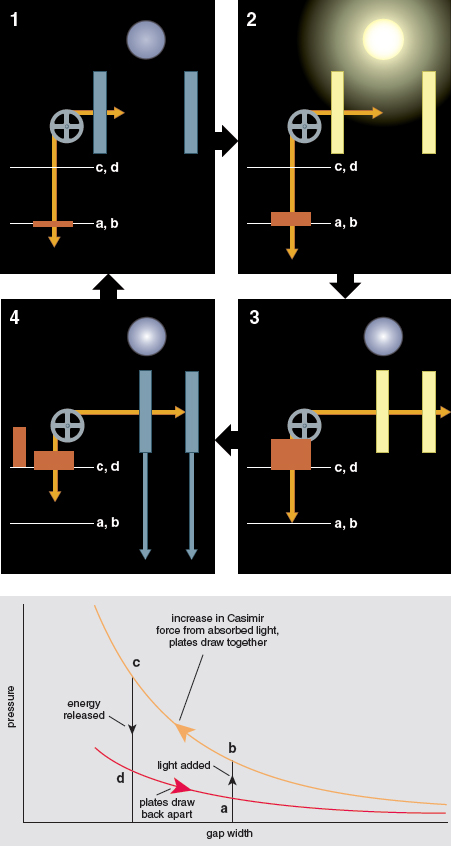
Illustration by Tom Dunne.
With the Casimir effect, this idea goes back to the first mention of zero-point energy. The Principle of Relativity (see “Lost in Einstein’s Shadow,” March–April 2006) predicts that the zero-point energy density anywhere in space should be infinite. However, extracting that energy in any useful manner is another matter. Robert L. Jaffe of the Massachusetts Institute of Technology has recently concluded that “no known phenomenon, including the Casimir effect, demonstrates that zero-point energies are real.”
An analysis by Marco Scandurra, then at the Universitá di Pisa, in a 2001 ArXiv contribution, leads to the only apparent remedy, that is, to maintain energy conservation in the semiconductor system, “the work we must do to recombine the electrons with the atoms is of course larger when the distance of the plates is small and it is presumably equal to the total energy released by the vacuum during the compression phase.”
I am personally comfortable with Scandurra’s conclusion and I am investigating specific systems to determine, beyond presumption, whether the energy released at the end of the cycle is determined by the net work done by dispersion forces in quantum electrodynamics, stochastic electrodynamics, and acoustic fields. If the net energy exchanged is equal to the work done, this result would preserve the First Law.
Several other issues still require clarification, including the generalization of the Lifshitz theory to real-world geometries different than the usual two-slab system, such as the surface of pollen grains or biological cells. With such rough surfaces, the force is expected to become quite complex and in some cases it could even become repulsive. Controlling when the Casimir effect is attractive or repulsive would be a major advance for MEMS devices, because stiction could be overcome. Research by Jeremy N. Munday, Federico Capasso, and V. Adrian Parsegian in 2009 demonstrated that the Casimir force can be made repulsive in some regimes if the gap between the materials is filled with a carefully selected substance with appropriate optical properties.
Another challenge is that calculating the Casimir force between two oddly shaped objects is very difficult with current methods. The system can only be approximated with a grid of points, rather than a continuous solution. A substantial step forward was taken in 2007 by Alejandro Rodriguez and his colleagues at MIT, who proved that finite-difference approaches standard in numerical electromagnetism can be successfully adapted to the task. In 2009, I carried out a detailed characterization of the process of convergence of their method toward known solutions and I adapted a procedure developed by Yih-Peng Chiou, Yen-Chung Chaing, and Hung-Chun Chang of National Taiwan University to show that it is possible to achieve a numerical solution that doesn’t require calculation of all the points on the grid, increasing the accuracy of the estimation without taxing computing resources beyond their current abilities. Without such accurate numerical solutions, we may know the origin of the source physically, but its behavior remains unknown quantitatively.
Another exciting research subfield is that of dispersion forces in the presence of gravitation, which could eventually see applications in increasing understanding of black holes, gravitational wave detection, and other aspects of cosmology. A detailed theoretical treatment, developed by Enrico Calloni and his colleagues at the Universitá Federico II di Napoli in 2002, led to the conclusion that the Casimir energy should experience a “push,” that is, a repulsion, by an ordinary mass such as that of the Earth. This outcome can be intuitively expected from the mass-energy equivalency, E=mc2, and the fact the Casimir energy is negative.
In practice, because a typical two-plate system has its own positive, mechanical mass and the negative Casimir energy mass-equivalent is smaller than one proton mass under any realistic conditions, this mass decrease is extremely challenging to detect. But devices called atomic gravimeters can measure the change in gravity affecting an atom and achieve relative sensitivities of the order of 10-13. Therefore I decided instead to concentrate on the measurement of the gravitational equivalent mass of the van der Waals energy between individual atoms confined in cold traps, which can be shown to be within present-day experimental capabilities.
This gravitational mass decrease can be further magnified by several orders of magnitude by exciting the trapped atoms to high-energy states, referred to as Rydberg states. The average distance of an excited electron from the nucleus in a Rydberg atom is much larger than in ground-state atoms (with radii around 100 picometers), in some cases becoming comparable to the size of a virus, about 100 nanometers in diameter. In these conditions, an atom is extremely fragile and far more easily deformed by external fields, corresponding to a vastly enhanced atomic polarizability and far better prospects for successful detection of this gravitational effect.
An intriguing connection between Casimir forces in gravitational fields and in metamaterials has also been uncovered. Metamaterials are fabricated structures not found in nature, presently being investigated because of their fascinating optical properties and their potential applications, as in “cloaking,” or invisibility. Because their optical response is described by dielectric functions equivalent to those that formally correspond to gravitational fields, metamaterials can be used to mimic Casimir forces in gravitational fields inaccessible in the laboratory, such as in black holes and in cosmology.
This approach has led to the suggestion by Tian-Ming Zhao and Rong-Min Miao of the University of Science and Technology of China in 2011 that the Casimir force in such structures may be enhanced by stunning factors as large as 1011 by a metamaterial based implementation of the narrow frequency-band strategies previously discussed. Not unexpectedly, the authors speculate that experiments in this field “may open a window to the use of vacuum energy” in practical ways.
Dispersion force engines should be capable of actuating nanosurgical robots deep inside the human body or powering next-generation thrusters in space.
In his 1981 text on Particle Physics and Introduction to Field Theory, Nobel Prize winner Tsung-Dao Lee intriguingly speculated: “The experimental method to alter the properties of the vacuum may be called vacuum engineering ... If indeed we are able to alter the vacuum, then because the vacuum is ever present and everywhere, our microscopic world of elementary particles would become inextricably connected to the macroscopic world of the cosmos.”
The main challenge for this developing quantum “vacuum engineering” now rests with interfacing cutting-edge science with the development of products that will both enhance the quality of human life and survive the notoriously harsh realities of the nanotechnology marketplace. We are now learning to exploit dispersion forces to purposefully build and operate, as Lee put it, “new, and doubtless beautiful, forms.”
le Science 62:37–56.
of Intermolecular Forces. Cambridge University Press: Cambridge.
nce. 338: 893-894.
Click "American Scientist" to access home page
American Scientist Comments and Discussion
To discuss our articles or comment on them, please share them and tag American Scientist on social media platforms. Here are links to our profiles on Twitter, Facebook, and LinkedIn.
If we re-share your post, we will moderate comments/discussion following our comments policy.